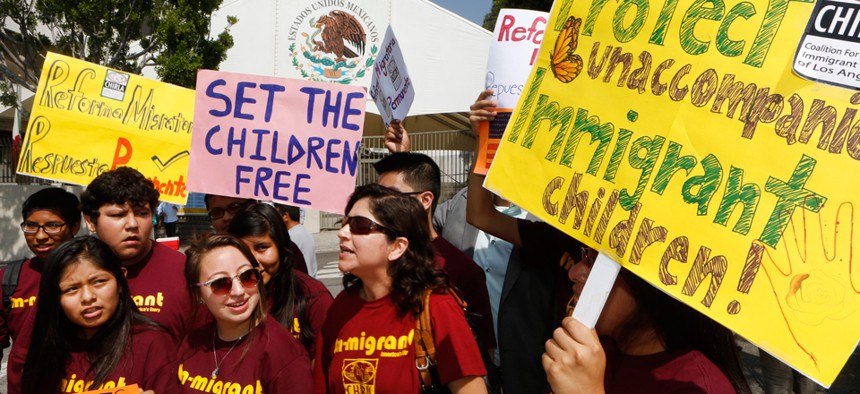
Immigration activists protest outside the Mexican consulate in Los Angeles. Damian Dovarganes/AP
The $3.7 Billion Obama is Seeking Won’t Stop the Surge of Desperate Child Migrants
Violence and poverty in Central America are among reasons child migrants cross.
Barack Obama has asked US lawmakers to allocate $3.7 billion to improve border security and address a humanitarian crisis that has spurred angry protests: the tens of thousands of child migrants that are being detained trying to cross into the United States from Mexico. But Obama’s plan, which would provide resources to house and process this surge of unaccompanied children more efficiently, would treat only the symptoms, not the disease.
Government statistics tell us where most of these children are coming from: Guatemala, Honduras and El Salvador. Over the last decade, US border patrol agents would generally apprehend around 4,000 child migrants a year from these countries. But just since October, almost 40,000 have been detained . So why are they coming here in such numbers, and now?
In part, it’s because their home countries are in trouble. Honduras, Guatemala, and El Salvador are among the top ten most violent nations in the world. Poverty is prevalent, and street gangs and drug cartels have seriously undermined the rule of law, especially after Mexico cracked down on narcotics trafficking after 2006, winning praise from US officials.

When United Nations officials interviewed 404 unaccompanied children (pdf) who had been detained on the way to the US last summer, most said they were attempting to reunite with their family living in America or to get a better life. But 58% cited violence or abuse as a reason for their departure, which could qualify them as refugees under international law. This a large increase from 2006, when a similar survey of children found only 13% mentioned such factors.
When children like this reach the US, often by way of human traffickers, a bipartisan law enacted in 2008 comes into play: Unless the children are from Mexico or Canada, in which case they are generally sent quickly back across the border, unaccompanied minors receive a hearing with an advocate in front of an immigration judge, and are to be given aid in reuniting with parents or seeking asylum. Now such cases are overwhelming the system, leaving some of these threatened children detained in poor conditions and vulnerable to abuse (paywall). Others are released to sponsors or relatives, with orders to appear at an immigration hearing later.
A perception that the US is easier on child migrants may have helped exacerbate the problem: Reports suggest that some smugglers, paid thousands of dollars to bring children to the border, coach them on what they should say to obtain protection. The challenge for US officials is to separate spurious claims from those of children fleeing legitimate dangers in countries where conditions are worsening measurably.
At the moment, Obama’s strategy is to invest in more immigration judges, border patrol agents, and detention facilities to expedite processing, so the backlog can be reduced and fewer children will have to live in limbo or in government custody while they await an immigration court’s decision. He may have trouble getting Congress to agree: Some critics in the opposition Republican party have indicated a reluctance to support any immigration policy of Obama’s, and within his own Democratic party, some have expressed discomfort with a plan that might send children back to dangerous situations.
Meanwhile, the US Customs and Border Patrol is paying for ads like these to be placed in the countries where many child migrants originate:

Ultimately, neither tactic will reduce the root instability in the Central American countries whose children are flooding across the border.
Of course, it isn’t easy to create economic opportunity or solve deep-seated social problems—and indeed, the US has shown itself unable to restrict the drug trade that moves through many of these countries on the way to high-demand markets in the US.
But if the US government is going to throw $3.7 billion at the symptoms, it should consider addressing the underlying disease of violence, poverty, and instability in Guatemala, Honduras and El Salvador—perhaps by upping the aid it sends to these three countries from the paltry $170.3 million scheduled for 2014.







